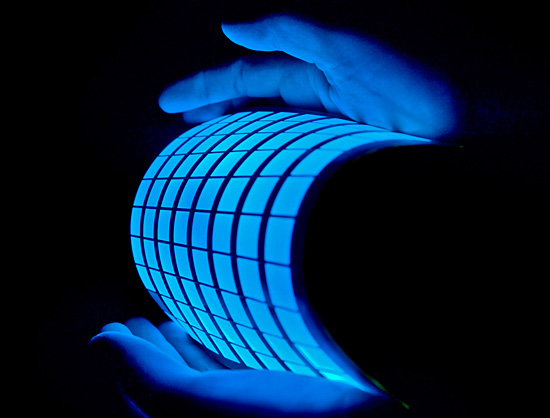
 OLEDs are the next generation display technology. They are already used in televisions, cell phones and computers, and they are candidates for a vast array of light sources from advertising billboards to indoor and outdoor illumination.
OLEDs are the next generation display technology. They are already used in televisions, cell phones and computers, and they are candidates for a vast array of light sources from advertising billboards to indoor and outdoor illumination.
Fluorescent OLEDs are typically less efficient at emitting light per unit area than their phosphorescent counterparts.
That may be changing, according to new findings by professor John Kieffer and graduate student Changgua Zhen of the Department of Materials Science and Engineering. They released findings in the journal Advanced Functional Materials that shattered previous records. Traditionally, the ceiling for the efficiency of fluorescent OLEDs was believed to be 5 percent. Now, Kieffer and his collaborators have produced fluorescent OLEDs with close to 10 percent efficiency.
University of Michigan engineering researchers have designed an exceptionally efficient fluorescent blue OLED, or organic light emitting diode.
“Our results clearly indicate that fluorescent material have a bright future for highly efficient and stable OLEDs for flat-panel display and lighting applications,” Kieffer said.
This was accomplished by redesigning a material being utilized by U-M collaborators in Singapore using computer simulations.
“With the material, they had some positive results,” Kieffer said. “We took those molecules and started to reconfigure them in a computer model, adding different functional groups in a systematic way. We identified the mechanisms that control the performance of OLEDs, and by applying the fundamental understanding so obtained we improved the materials characteristics. Our research demonstrated the importance of simulation-based predictive design.”
The paper is called: “Achieving Highly Efficient Fluorescent Blue Organic Light-Emitting Diodes Through Optimizing Molecular Structures and Device Configuration”
The research was funded by the Michigan Memorial Phoenix Energy Institute (MMPEI) and the Institute of Materials Research and Engineering (IMRE).



